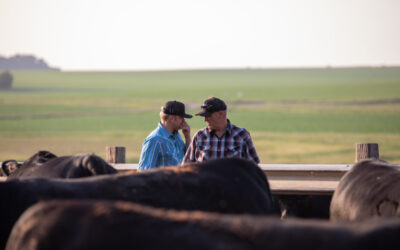
One sick calf = less profitable pen
Health costs impact entire feedyard
By Miranda Reiman
January 2009
Low mortality isn’t the only way to measure the success of your health program.
Pfizer veterinarian Robin Falkner told attendees at last fall’s Feeding Quality Forums, held in North Platte, Neb., and Amarillo, Texas, to start thinking about disease management a little differently.
“We want to worry about things that can change and that can matter,” he said.
Consider the steer with a 10% chance of living. A cowboy treats him, sends him to a holding pen and spends extra time with him – only to increase his chance of survival to 14%.
“Your total focus is on saving that one,” Falkner noted. “How much of my time can I burn up on him that I could better invest somewhere else? In this situation, the bunks aren’t cleaned out. The water troughs aren’t getting cleaned. We don’t have that extra five minute in another pen to pull one early.”
A change of mindset would help the bottom line, Falkner said: “We need to move away from asking what can we do to save him to asking what he can kill.”
That’s because the real risk goes beyond wasting time. That one calf is shedding to the rest of the population – after all, he has pathogens that have already beaten the drugs and management at that yard, Falkner said. “That’s why it’s not about saving him. It’s about saving the other calves.”
Rather than managing health on an animal-by-animal basis, feeders need to think of keeping disease under control in groups of cattle and their yard as a whole.
“I’m not a veterinarian who thinks the world revolves around health, but if you intentionally manage pathogens, your world will change,” Falkner said. He referenced Texas Ranch-to-Rail data that shows a sick calf costs $100, and Iowa research illustrates a 10-point drop in Certified Angus Beef ® (CAB®) acceptance rate for calves treated twice.
“That’s not the whole story, though, because it affected the other calves in the pen,” he said. Sick cattle cause problems with everything from bunk reading to final marketing, but managing health will improve both the efficiency of groups of cattle and the feedyard as a whole.
“Does heath impact any decisions we make about filling pens at any point in time? I think it’s the biggest bottleneck to profitability we’ve got,” Falkner said. “We are scared to buy certain types and classes of cattle because we don’t know if we can handle the health. We’re scared to wreck and overload our labor.”
When those health disasters happen, feeders often put off buying until they have it under control. Some try to change vaccines, nutritionist, veterinarians or even order buyers.
“Switching a good program to one you don’t know is probably not a good deal,” he said.
Instead, Falkner provided some practical prevention recommendations, including not placing your hospital pen next door to receiving.

“You don’t know how many feedyards I’ve been to where the cattle are going to stand right next to a pen of chronics, overnight, before they’re processed in the morning,” he said. Following up with ironic humor, he asked, “Are you just trying to inoculate them early so we can go ahead and get over it? We make sure we give our brand new, naïve, stressed-out cattle good, early access to the worst bugs we’ve collected in the past six months, year or 10 years.”
He also suggests keeping cattle out of that treatment pen if at all possible.
“A low flow of cattle into the hospital works well, because that flushes the bugs out regularly and they don’t accumulate as much,” he said.
Cattle that have been in the yard for 10 to 35 days are the “most dangerous,” Falkner said. “The bugs have all gone through them and they’re shedding a whole lot.”
Sometimes sickness doesn’t show itself in one group of cattle until you mix them with another after they’ve had a couple of weeks to get settled in the yard.
“You create the perfect storm and you blow them completely up,” he said. “This disease is going on in one group and by itself it’s not any more than a runny nose, but you put it on top of another disease that’s going through the other group and it’s really bad.”
Taking a careful look at every aspect of bio-containment could help prevent “real wrecks,” Falkner said. “You’re going to get the bad bugs. You’re going to select for them when you use those drugs, but you don’t have to accumulate them and you don’t have to inoculate them.”
The meetings were cosponsored by Pfizer Animal Health, Certified Angus Beef LLC (CAB), Feedlot magazine and Land O’ Lakes Purina Feed.
You may also like
Consumer Demand, Power of Quality
Demand for high-quality beef persists. But with that demand comes challenges. From tight cattle supplies to higher costs and increasing pressure on retailers to deliver a consistent eating experience, the pressure is on. David O’Diam, CAB VP of retail, addressed the current retail beef environment, highlighting both opportunities and challenges in today’s marketplace.
System Over Scale
For Dallas Knobloch, it’s not about being the biggest feedyard—it’s about building a high-quality system that works. Today, with Tory’s wife Sadie and daughter Ivy, the Knobloch family owns and operates 4K Cattle. They feed 2,500 cattle at eight locations within 10 miles of home, manage 1,000 acres of crops and run a 125-head cow herd, all near Hills, Minn.
Data-Driven Progress and Partnerships
Discussions at Feeding Quality Forum reaffirmed the industry’s commitment to quality, transparency and innovation. With record Prime rates and strong consumer demand, producers who invest in genetics, health and relationships are positioned to drive progress and capture premiums.



